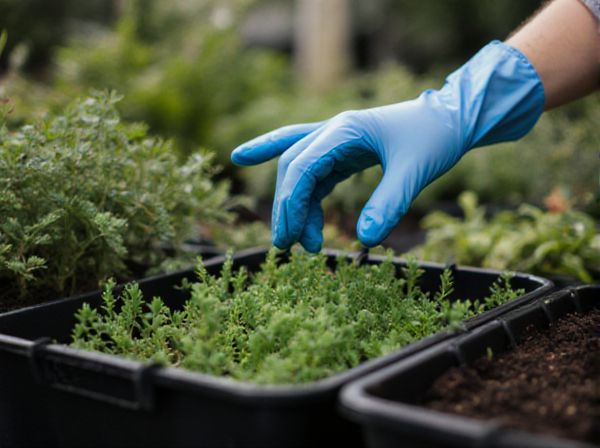
Tissue culture vs Cuttings Illustration
Tissue culture enables rapid propagation of plants under sterile, controlled conditions, producing disease-free and genetically uniform clones with higher multiplication rates than cuttings. Cuttings rely on the natural ability of plant parts to root and develop into independent plants, which can be slower and more variable but require less specialized equipment. Both methods serve propagation needs, with tissue culture offering precision and scalability, while cuttings provide simplicity and cost-effectiveness for smaller-scale production.
Table of Comparison
| Aspect | Tissue Culture | Cuttings |
|---|---|---|
| Definition | In vitro propagation of plants using small tissue samples | Vegetative propagation by rooting plant stem or leaf sections |
| Propagation Speed | Fast mass production of identical plants | Slower, dependent on rooting and growth rates |
| Genetic Uniformity | Produces genetically identical clones | May have minor genetic variations |
| Environmental Control | Requires sterile lab conditions and controlled environment | Can be done in natural or greenhouse conditions |
| Cost | Higher initial investment; cost-effective for large scale | Lower cost; suitable for small-scale propagation |
| Disease Risk | Low; sterile process reduces pathogen risk | Higher; risk of transmitting diseases through cuttings |
| Plant Types | Effective for orchids, ferns, difficult-to-root species | Commonly used for shrubs, trees, and herbaceous plants |
| Skill Required | Requires specialized training and equipment | Simple technique; minimal training needed |
Introduction to Plant Propagation Methods
Tissue culture and cuttings are two primary plant propagation methods used to produce genetically identical plants. Tissue culture involves growing plants from small tissue samples in a sterile, nutrient-rich environment, ensuring rapid multiplication and disease-free plants. Cuttings propagate plants by rooting sections of stems, leaves, or roots, offering simplicity and cost-effectiveness for many species.
What is Tissue Culture Propagation?
Tissue culture propagation is a method of plant propagation that involves growing new plants from a small group of cells or tissues in a sterile, nutrient-rich environment. This technique allows for rapid multiplication of genetically identical plants, ensuring uniformity and disease-free growth. Unlike cuttings, which rely on rooting a part of a parent plant, tissue culture enables the production of large numbers of plants from minimal starting material in a controlled laboratory setting.
Understanding Propagation by Cuttings
Propagation by cuttings involves selecting a healthy stem or leaf section from a parent plant to stimulate root growth and develop into a new plant, offering a faster and more cost-effective method compared to tissue culture. This technique relies on the natural ability of certain plants to regenerate roots from cut sections, ensuring genetic consistency with the parent plant, unlike the more controlled, sterile environment required for tissue culture. Understanding propagation by cuttings is essential for optimizing success rates in horticulture, especially for species that root easily and benefit from minimal equipment and setup.
Key Differences: Tissue Culture vs. Cuttings
Tissue culture involves growing plants from small tissue samples in sterile, controlled environments, enabling rapid production of disease-free and genetically uniform plants. Cuttings rely on plant segments like stems or leaves, rooting them in soil or water, which is simpler but slower and may carry disease risks. Tissue culture offers higher scalability and consistency, while cuttings are more cost-effective and accessible for small-scale propagation.
Advantages of Tissue Culture in Gardening
Tissue culture in gardening offers significant advantages such as producing disease-free, genetically uniform plants that ensure consistent crop quality. This method enables rapid multiplication of plants in a controlled environment, overcoming seasonal constraints and space limitations faced by traditional cuttings. By allowing precise control over growing conditions, tissue culture enhances plant vigor and survival rates compared to conventional propagation techniques.
Benefits of Using Cuttings for Propagation
Cuttings offer a cost-effective and straightforward propagation method that enables faster plant multiplication compared to tissue culture. They maintain genetic fidelity, ensuring the new plants retain the parent plant's desirable traits without the risk of somaclonal variation seen in tissue culture. Using cuttings also allows for propagation without specialized laboratory equipment, making it accessible for both hobbyists and commercial growers.
Limitations of Tissue Culture Propagation
Tissue culture propagation faces limitations such as high initial setup costs, requiring sterile laboratory conditions and skilled technicians. Contamination risks are significant, often leading to loss of cultures and inconsistent plant quality. Additionally, some plant species exhibit low regeneration rates or somaclonal variation, affecting uniformity and commercial scalability.
Drawbacks of Propagation by Cuttings
Propagation by cuttings often faces limitations such as a higher risk of disease transmission due to direct contact with the parent plant. Rooting success rates can be variable and are influenced by environmental factors like humidity and temperature, resulting in inconsistent growth. This method also lacks genetic diversity, which can make plants more susceptible to pests and environmental stresses compared to tissue culture propagation.
Best Practices for Successful Propagation
Tissue culture offers a sterile environment that minimizes disease risks and ensures genetic uniformity, making it ideal for large-scale propagation of plants requiring high consistency. Cuttings require careful selection of healthy parent material, proper hormone treatment, and controlled humidity and temperature to enhance root development and improve survival rates. Combining precise environmental control with appropriate propagation techniques significantly increases the success rate in both tissue culture and cutting methods.
Choosing the Right Method for Your Garden
Selecting the appropriate propagation method depends on plant species, growth goals, and available resources. Tissue culture offers rapid, disease-free multiplication ideal for large-scale production, while cuttings provide a cost-effective, straightforward approach suitable for home gardeners and specific plants. Evaluating factors like time, skill level, and desired uniformity ensures optimal propagation success in your garden.
Tissue culture vs Cuttings Infographic

 gardendif.com
gardendif.com